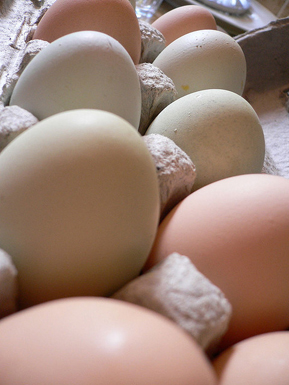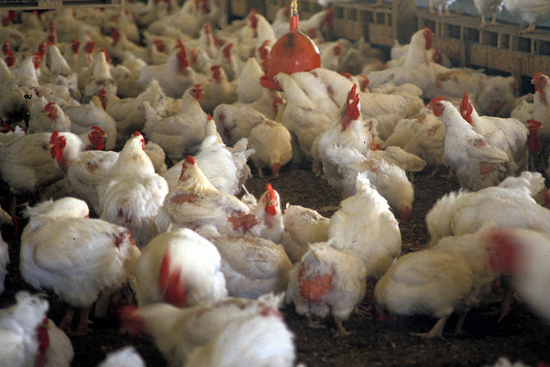BU to Take Its Eggs Cage-Free
Student campaign wins change for fall semester

Whoever said one man’s actions don’t count hasn’t met Nathan Shin.
Last semester Shin (CAS’12) heard about a student-run campaign sweeping local college campuses that was successfully lobbying administrators to buy only cage-free eggs for their food services. Shin, a vegan member of the Vegetarian Society, did some sleuthing and discovered that Aramark, BU’s food service provider, did not buy exclusively cage-free eggs. He and other club members, including event coordinator Kelseanna Smith (CGS’11, CAS’13) and treasurer Rachel Atcheson (CAS’13), met last semester with Dining Services officials, who were reluctant to push for change without campus-wide student support.
So that’s what Shin set about getting. He and a group of friends collected 1,500 signatures and conducted surveys asking students if the University should serve only cage-free eggs. An overwhelming 97 percent responded yes, regardless of cost.
In early December, Shin and his group presented their results to the Student Union, which voted unanimously in favor of the idea. Administrators agreed shortly thereafter to change BU’s buying practices and instruct suppliers to provide the University with only cage-free shell and liquid eggs.
The experience taught Shin a key lesson: “It’s important for students to know that they can change the school they go to.”
University dining halls have been using cage-free eggs for two years in their a la carte menu for such items as omelets and boiled eggs. But as of next September, all eggs, including liquid eggs and those used for baking, will be cage-free. The switch was announced today on the Dining Services website.
Most egg-laying chickens are raised in tightly packed battery cages with no room to turn around, nest, perch, or dust bathe—all natural instincts for the birds.
“It’s really a nightmare situation, where they’re stacked on top of each other in the dark,” says David Coman-Hidy, director of campaigns for the animal protection nonprofit Humane League. Coman-Hidy helped organize BU’s successful effort and others at Harvard, Brandeis, Emerson, and Lesley Universities.
Cage-free chickens, on the other hand, live in large flocks in barns and can walk around, spread their wings, nest, perch, and dust bathe (instead of using water, chickens clean themselves and get rid of parasites by finding warm, dry, loose material like dirt, sand, or mulch, digging themselves in, then shaking off the dirt and dust). While not allowed to roam outdoors, these chickens have a better life than those raised in battery cages.

Coman-Hidy uses a metaphor to describe the two practices. “Think of battery cages as solitary confinement,” he says, “and cage-free as general population prison.”
What eventually won over BU administrators was the idea of minimizing animal cruelty. “We believe it’s important to make a statement on the more humane treatment of chickens,” says Marc Robillard, executive director of housing and dining.
Robillard estimates that the switch will cost BU an additional $80,000 a year, noting that the increase will not be passed on to students, but will be absorbed in the operating budget. Raising cage-free eggs is a more labor-intensive process, which contributes to higher market costs (a dozen cage-free eggs are nearly double the price of a regular dozen).
Nutritionally, cage-free eggs are no different than those produced by battery cage hens, according to Joan Salge-Blake (SAR’84), a Sargent College clinical associate professor of nutrition. The same is true for organic or free-range eggs. Nutritional value changes only when the quality of chicken feed is altered, as when supplements like vitamin E are added to grain.
With this change, BU joins a larger, nationwide movement supporting more humane treatment of egg-laying chickens. Legislation was recently introduced in Congress that would eliminate battery cages over the next 15 years and replace them with roomier quarters, with amenities like perches and nesting boxes. The bill, endorsed in an editorial column in today’s New York Times, is backed by odd bedfellows—the Humane Society, the nation’s largest animal protection organization, and the United Egg Producers, which represents the U.S. egg industry. Should it pass, the legislation would force better conditions in states that likely would never have considered them (a boon for animal supporters) and prevent a state-by-state legislative battle over cage requirements (a plus for the egg industry).
For his part, Shin says he plans to continue fighting for animal rights after graduation.
“If we actually pride ourselves on being environmentally friendly, I think that the community has to realize what choices they make food-wise,” Shin says. “The food industry is one of the biggest impacts that we have on the environment. If we want to be green, we have to eat green.”
Comments & Discussion
Boston University moderates comments to facilitate an informed, substantive, civil conversation. Abusive, profane, self-promotional, misleading, incoherent or off-topic comments will be rejected. Moderators are staffed during regular business hours (EST) and can only accept comments written in English. Statistics or facts must include a citation or a link to the citation.